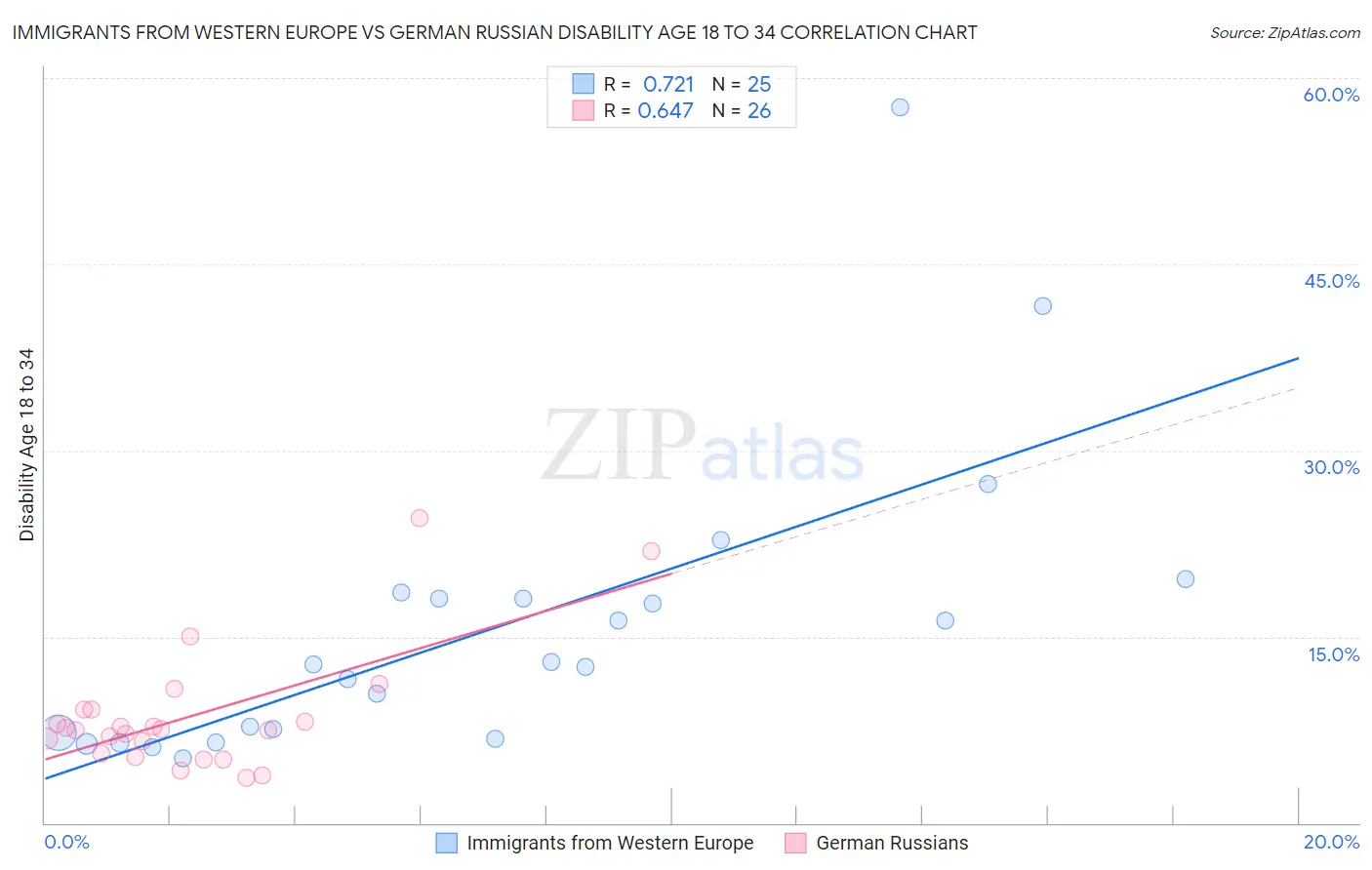Immigrants from Western Europe vs German Russian Disability Age 18 to 34
COMPARE
Immigrants from Western Europe
German Russian
Disability Age 18 to 34
Disability Age 18 to 34 Comparison
Immigrants from Western Europe
German Russians
6.9%
DISABILITY AGE 18 TO 34
9.1/ 100
METRIC RATING
213th/ 347
METRIC RANK
7.4%
DISABILITY AGE 18 TO 34
0.1/ 100
METRIC RATING
266th/ 347
METRIC RANK
Immigrants from Western Europe vs German Russian Disability Age 18 to 34 Correlation Chart
The statistical analysis conducted on geographies consisting of 491,827,703 people shows a strong positive correlation between the proportion of Immigrants from Western Europe and percentage of population with a disability between the ages 18 and 35 in the United States with a correlation coefficient (R) of 0.721 and weighted average of 6.9%. Similarly, the statistical analysis conducted on geographies consisting of 96,377,873 people shows a significant positive correlation between the proportion of German Russians and percentage of population with a disability between the ages 18 and 35 in the United States with a correlation coefficient (R) of 0.647 and weighted average of 7.4%, a difference of 7.2%.

Disability Age 18 to 34 Correlation Summary
| Measurement | Immigrants from Western Europe | German Russian |
| Minimum | 5.2% | 3.7% |
| Maximum | 57.7% | 24.5% |
| Range | 52.5% | 20.8% |
| Mean | 15.8% | 8.6% |
| Median | 12.8% | 7.5% |
| Interquartile 25% (IQ1) | 7.0% | 5.6% |
| Interquartile 75% (IQ3) | 18.3% | 9.1% |
| Interquartile Range (IQR) | 11.3% | 3.5% |
| Standard Deviation (Sample) | 12.0% | 4.9% |
| Standard Deviation (Population) | 11.8% | 4.9% |
Similar Demographics by Disability Age 18 to 34
Demographics Similar to Immigrants from Western Europe by Disability Age 18 to 34
In terms of disability age 18 to 34, the demographic groups most similar to Immigrants from Western Europe are Luxembourger (6.9%, a difference of 0.070%), Immigrants from Norway (6.8%, a difference of 0.18%), Serbian (6.9%, a difference of 0.18%), Immigrants from Thailand (6.9%, a difference of 0.34%), and Latvian (6.8%, a difference of 0.37%).
| Demographics | Rating | Rank | Disability Age 18 to 34 |
| Japanese | 12.8 /100 | #206 | Poor 6.8% |
| Mexicans | 12.6 /100 | #207 | Poor 6.8% |
| Immigrants | Scotland | 12.4 /100 | #208 | Poor 6.8% |
| Immigrants | Burma/Myanmar | 12.3 /100 | #209 | Poor 6.8% |
| Latvians | 11.1 /100 | #210 | Poor 6.8% |
| Immigrants | Norway | 10.0 /100 | #211 | Tragic 6.8% |
| Luxembourgers | 9.4 /100 | #212 | Tragic 6.9% |
| Immigrants | Western Europe | 9.1 /100 | #213 | Tragic 6.9% |
| Serbians | 8.2 /100 | #214 | Tragic 6.9% |
| Immigrants | Thailand | 7.5 /100 | #215 | Tragic 6.9% |
| Sudanese | 7.0 /100 | #216 | Tragic 6.9% |
| Immigrants | Kenya | 6.9 /100 | #217 | Tragic 6.9% |
| Ukrainians | 6.7 /100 | #218 | Tragic 6.9% |
| Hawaiians | 6.5 /100 | #219 | Tragic 6.9% |
| Immigrants | Senegal | 5.5 /100 | #220 | Tragic 6.9% |
Demographics Similar to German Russians by Disability Age 18 to 34
In terms of disability age 18 to 34, the demographic groups most similar to German Russians are Bangladeshi (7.4%, a difference of 0.060%), Portuguese (7.4%, a difference of 0.14%), Slovene (7.3%, a difference of 0.17%), Basque (7.4%, a difference of 0.18%), and Bermudan (7.3%, a difference of 0.19%).
| Demographics | Rating | Rank | Disability Age 18 to 34 |
| Somalis | 0.2 /100 | #259 | Tragic 7.3% |
| Tohono O'odham | 0.2 /100 | #260 | Tragic 7.3% |
| Northern Europeans | 0.2 /100 | #261 | Tragic 7.3% |
| Canadians | 0.2 /100 | #262 | Tragic 7.3% |
| British | 0.2 /100 | #263 | Tragic 7.3% |
| Bermudans | 0.1 /100 | #264 | Tragic 7.3% |
| Slovenes | 0.1 /100 | #265 | Tragic 7.3% |
| German Russians | 0.1 /100 | #266 | Tragic 7.4% |
| Bangladeshis | 0.1 /100 | #267 | Tragic 7.4% |
| Portuguese | 0.1 /100 | #268 | Tragic 7.4% |
| Basques | 0.1 /100 | #269 | Tragic 7.4% |
| Belgians | 0.1 /100 | #270 | Tragic 7.4% |
| Swiss | 0.1 /100 | #271 | Tragic 7.4% |
| Tsimshian | 0.1 /100 | #272 | Tragic 7.4% |
| Slavs | 0.1 /100 | #273 | Tragic 7.4% |